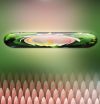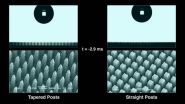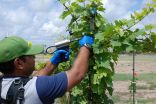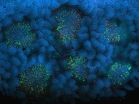(Press-News.org) WASHINGTON, D.C., August 4, 2015 -- Studies of the impact a droplet makes on solid surfaces hark back more than a century. And until now, it was generally believed that a droplet's impact on a solid surface could always be separated into two phases: spreading and retracting.
But it's much more complex than that, as a team of researchers from City University of Hong Kong, Ariel University in Israel, and Dalian University of Technology in China report in the journal Applied Physics Letters, from AIP Publishing.
"During the spreading phase, the droplet undergoes an inertia-dominant acceleration and spreads into a 'pancake' shape," explained Zuankai Wang, an associate professor within the Department of Mechanical and Biomedical Engineering at the City University of Hong Kong. "And during the retraction phase, the drop minimizes its surface energy and pulls back inward."
Remarkably, on gold standard superhydrophobic--a.k.a. repellant--surfaces such as lotus leaves, droplets jump off at the end of the retraction stage due to the minimal energy dissipation during the impact process. This is attributed to the presence of an air cushion within the rough surface.
There exists, however, a classical limit in terms of the contact time between droplets and the gold standard superhydrophobic materials inspired by lotus leaves.
As the team previously reported in the journal Nature Physics, it's possible to shape the droplet to bounce from the surface in a pancake shape directly at the end of the spreading stage without going through the receding process. As a result, the droplet can be shed away much faster.
"Interestingly, the contact time is constant under a wide range of impact velocities," said Wang. "In other words: the contact time reduction is very efficient and robust, so the novel surface behaves like an elastic spring. But the real magic lies within the surface texture itself."
To prevent the air cushion from collapsing or water from penetrating into the surface, conventional wisdom suggests the use of nanoscale posts with small inter-post spacings. "The smaller the inter-post spacings, the greater the impact velocity the small inter-post can withstand," he elaborated. "By contrast, designing a surface with macrostructures--tapered sub-millimeter post arrays with a wide spacing--means that a droplet will shed from it much faster than any previously engineered materials."
What the New Results Show
Despite exciting progress, rationally controlling the contact time and quantitatively predicting the critical Weber number--a number used in fluid mechanics to describe the ratio between deforming inertial forces and stabilizing cohesive forces for liquids flowing through a fluid medium--for the occurrence of pancake bouncing remained elusive.
So the team experimentally demonstrated that the drop bouncing is intricately influenced by the surface morphology. "Under the same center-to-center post spacing, surfaces with a larger apex angle can give rise to more pancake bouncing, which is characterized by a significant contact time reduction, smaller critical Weber number, and a wider Weber number range," according to co-authors Gene Whyman and Edward Bormashenko, both professors at Ariel University.
Wang and colleagues went on to develop simple harmonic spring models to theoretically reveal the dependence of timescales associated with the impinging drop and the critical Weber number for pancake bouncing on the surface morphology. "The insights gained from this work will allow us to rationally design various surfaces for many practical applications," he added.
The team's novel surfaces feature a shortened contact time that prevents or slows ice formation. "Ice formation and its subsequent buildup hinder the operation of modern infrastructures--including aircraft, offshore oil platforms, air conditioning systems, wind turbines, power lines, and telecommunications equipment," Wang said.
At supercooled temperatures, which involves lowering the temperature of a liquid or gas below its freezing point without it solidifying, the longer a droplet remains in contact with a surface before bouncing off the greater the chances are of it freezing in place. "Our new surface structure can be used to help prevent aircraft wings and engines from icing," he said.
This is highly desirable, because a very light coating of snow or ice--light enough to be barely visible--is known to reduce the performance of airplanes and even cause crashes. One such disaster occurred in 2009, and called attention to the dangers of in-flight icing after it caused Air France Flight 447 flying from Rio de Janeiro to Paris to crash into the Atlantic Ocean.
Beyond anti-icing for aircraft, "turbine blades in power stations and wind farms can also benefit from an anti-icing surface by gaining a boost in efficiency," he added.
As you can imagine, this type of nature-inspired surface shows potential for a tremendous range of other applications as well--everything from water and oil separation to disease transmission prevention.
The next step for the team? To "develop bioinspired 'active' materials that are adaptive to their environments and capable of self-healing," said Wang.
INFORMATION:
The article, "Controlling drop bouncing using surfaces with gradient features" is authored by Yahua Liu, Gene Whyman, Edward Bormashenko, Chonglei Hao, and Zuankai Wang. It will appear in the journal Applied Physics Letters on August 4, 2015. After that date, it can be accessed at: http://scitation.aip.org/content/aip/journal/apl/107/5/10.1063/1.4927055
The authors of this paper are affiliated with City University of Hong Kong, Dalian University of Technology, Ariel University, and Shenzhen Research Institute of City University of Hong Kong
ABOUT THE JOURNAL
Applied Physics Letters features concise, rapid reports on significant new findings in applied physics. The journal covers new experimental and theoretical research on applications of physics phenomena related to all branches of science, engineering, and modern technology. See: http://apl.aip.org
UBC scientists have opened the doors to new research into malnutrition by creating an animal model that replicates the imbalance of gut bacteria associated with the difficult-to-treat disease.
Malnutrition affects millions of people worldwide and is responsible for one-fifth of deaths in children under the age of five. Children can also experience impaired cognitive development and stunted growth.
The problem arises when people don't have enough food to eat and their diet lacks proper nutrients. The disease also has a lot to do with environmental factors and it has ...
In vitro studies of the cellular effects of modeled osteopathic manipulative therapy (OMT) provide proof of concept for the manual techniques practiced by doctors of osteopathic medicine (DOs), according to researchers from the University of Arizona College of Medicine - Phoenix.
The study, published in The Journal of the American Osteopathic Association, focused on modeling two common OMT techniques, myofascial release and counterstrain. Researchers subjected fibroblast matrices to various strains and employed a scratch wound strain model to test the ability of OMT ...
A new strain of yeast called Yarrowia lipolytica Y-3492 was found to be very active in waste water treatment. The discovery was made by by microbiologists from Kazan Federal University during their research at Western Siberian peat bogs.
The strain is said to be effective against nitro compounds which are used in explosives, herbicides, insecticides, polymers, dyes, and some medications. Oil refineries and military equipment plants produce especially high amounts of such waste. The research was conducted with the use of widely known trinitrotoluene (TNT).
It is well-known ...
COLLEGE STATION -- It's happy hour at a lab in College Station. The cocktail of choice, developed by scientists with Texas A&M AgriLife Research, is one that stops or prevents the deadly Pierce's disease on wine grapes.
The discovery could turn a new leaf on the multimillion-dollar U.S. wine industry. Hear, hear.
The study, published in the academic journal PLOS ONE, describes the use of four bacteriophages that were identified for their ability to attack the bacteria that causes the devastating disease in grapes and several other plants.
A bacteriophage, or phage, ...
A paper from the University of Exeter has highlighted the dangers of relying on climate-based projections of future crop pest distributions and suggests that rapid evolution can confound model results.
Crop pests and pathogens are destructive organisms which pose a huge threat to food security and land management across the world. Much research has been carried out into why the pests are spreading, where they are likely to establish next, what damage they will do and what can be done to reduce their impact.
In a new synthesis, published today in the Annual Review of ...
Diagnosis of deadly brain conditions could be helped by new research that shows how infectious proteins that cause the disease spread.
The study reveals how the proteins - called prions - spread from the gut to the brain after a person or animal has eaten contaminated meat.
Scientists say their findings could aid the earlier diagnosis of prion diseases - which include variant Creutzfeldt-Jakob disease (vCJD) in people and bovine spongiform encephalopathy (BSE) in cows.
In people, the disease remains very rare - 229 people have died from vCJD since it was first identified ...
The Society of Thoracic Surgeons, the Society of Cardiovascular Anesthesiologists, and the American Society of ExtraCorporeal Technology have released a set of clinical practice guidelines to address management of a patient's temperature during open heart surgery. The guidelines appear in the August issue of The Annals of Thoracic Surgery and were published simultaneously in two other journals.
Numerous strategies are currently used to optimally manage the practice of cooling the blood, temperature maintenance (control of body temperature during surgery), and rewarming ...
This news release is available in French. While it is already possible to obtain in vitro pluripotent cells (ie, cells capable of generating all tissues of an embryo) from any cell type, researchers from Maria-Elena Torres-Padilla's team have pushed the limits of science even further. They managed to obtain totipotent cells with the same characteristics as those of the earliest embryonic stages and with even more interesting properties. Obtained in collaboration with Juanma Vaquerizas from the Max Planck Institute for Molecular Biomedicine (Münster, Germany), these ...
Women who exercised during their teen years were less likely to die from cancer and all other causes during middle-age and later in life, according to a new study by investigators at Vanderbilt University Medical Center and the Shanghai Cancer Institute in China.
The study was published online July 31 in Cancer Epidemiology, Biomarkers & Prevention, a journal of the American Association of Cancer Research.
Lead author Sarah Nechuta, Ph.D., MPH, assistant professor of Medicine in the Vanderbilt Epidemiology Center, said understanding the long-term impact of modifiable ...
GAINESVILLE, Fla. -- UF Health researchers have found that care linked to heart attacks and chronic obstructive pulmonary disease, or COPD, among disabled adults covered by Medicaid has improved with the expansion of a new health care program in Texas over the last decade.
This approach to health care delivery is growing in popularity across the country, with the number of states implementing similar programs increasing from eight in 2004 to 18 in 2014. These programs have two components: managed care and home- and community-based health services. Managed care is reputed ...





